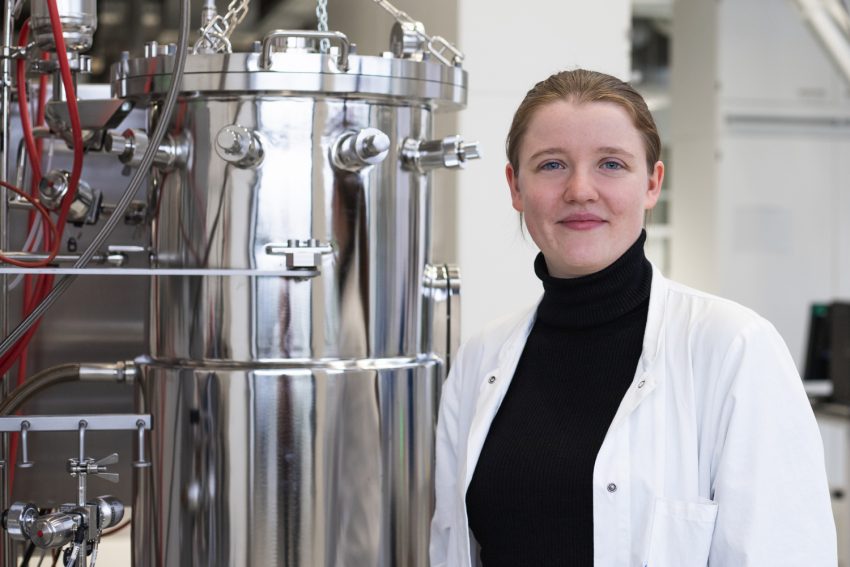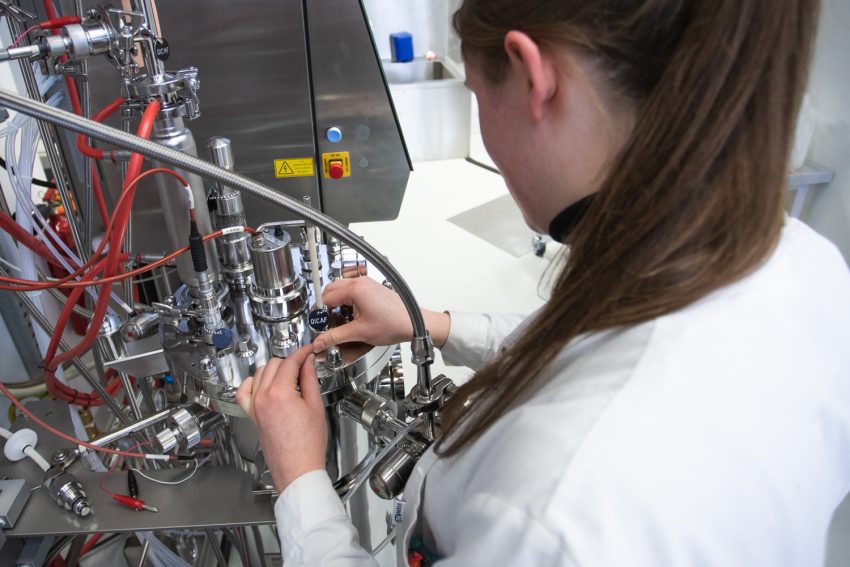Using yeast to produce active substances A short portrait of Rebekka Mögenburg from the doctoral programme "Drug Discovery and Chemical Informatics for New Anti-Infectives".
Yeasts are small unicellular fungi that can multiply rapidly through cell division. Many people know yeast, for example, from its use in baking bread or brewing beer. But it can also be used in drug research. Rebekka Mögenburg is a doctoral student in the doctoral programme “Drug Discovery and Chemical Informatics for New Anti-Infectives” in the research focus Infections and Therapeutics of the Technische Universität Braunschweig and is investigating how active substances from the medicinal plant St. John’s wort can be produced with the help of yeast. We present a short portrait of the biotechnologist.

Doctoral student Rebekka Mögenburg is conducting research in the doctoral programme “Drug Discovery and Chemical Informatics for New Anti-Infectives”. Picture credits: Max Fuhrmann/TU Braunschweig
Who are you and what are you researching?
I’m Rebekka Mögenburg and I’m earning my PhD at the Institute of Pharmaceutical Biology at TU Braunschweig. Before that, I did my bachelor’s and master’s degrees in biology with a focus on biotechnology at the Ruhr University in Bochum. In my current research, I am trying to extract new antimicrobial substances from St. John’s wort with the help of enzymes and to produce them in larger quantities in yeast. Antimicrobial substances are substances that impair the growth of microorganisms or kill or inactivate them.
What specific research question are you pursuing?
My research relates specifically to the substance class of xanthones. From a chemical point of view, they are a ring system as a core structure with different side chains. Various xanthones have already been found in St. John’s wort that have an antimicrobial effect. My goal is to have these xanthones synthesised by yeast, i.e. to use yeast as a customised cell factory, and then to test the xanthones for their antimicrobial effect. In the end, I might be able to discover a new active ingredient against the multi-resistant bacterium Staphylococcus aureus (MRSA) and also produce it in such a quantity, for example at the Centre of Pharmaceutical Engineering, that it can be used for further research into drugs.
What excites you about your research?
What excites me most about my work is that it is very application-oriented. This includes so-called metabolic engineering, which is used to reconstruct and optimise biosynthetic pathways in microorganisms. With the help of metabolic engineering, I may be able to lay the foundation for a new drug whose active ingredient would be cheaper to produce in yeast or could even be produced exclusively by yeast. But this is a big challenge and I still have a long way to go. My work also excites me because I am laying an important foundation for further research in this field to help people fight the increasing number of multidrug-resistant bacteria.

In einem Bioreaktor werden Mikroorganismen für die Forschung kultiviert. Bildnachweis: Max Fuhrmann/TU Braunschweig
What relevance does the topic have for drug research?
Many active substances only occur in small quantities in the plants that produce them. Therefore, the reconstruction of their biosynthetic pathways in microorganisms such as yeast opens up great opportunities. The possibility of producing a new drug against multidrug-resistant bacteria in yeast brings a number of advantages. Yeast can be grown in large bioreactors, is easy to maintain and requires only inexpensive components for reproduction and substance synthesis. Producing a drug in this way could reduce costs many times over, making it relevant to the production of a wide range of other drugs.
What is special about participating in the PhD programme “Drug Discovery and Chemical Informatics for New Anti-Infectives (iCA)”?
In this programme, doctoral students from many different fields of study come together. Through the exchange of theoretical background knowledge from the different fields, but also of practical methods and experiences in the laboratory, a fruitful interdisciplinary research is possible, which I would not have been able to experience otherwise. The programme enables me not only to view my own questions from a different perspective, but also to provide doctoral students from other disciplines with the opportunity to solve biological problems. This project underlines the fact that the future of pharmaceutical research does not rest on the shoulders of just one department, but is supported to a large extent by the future researchers in an interdisciplinary way.
